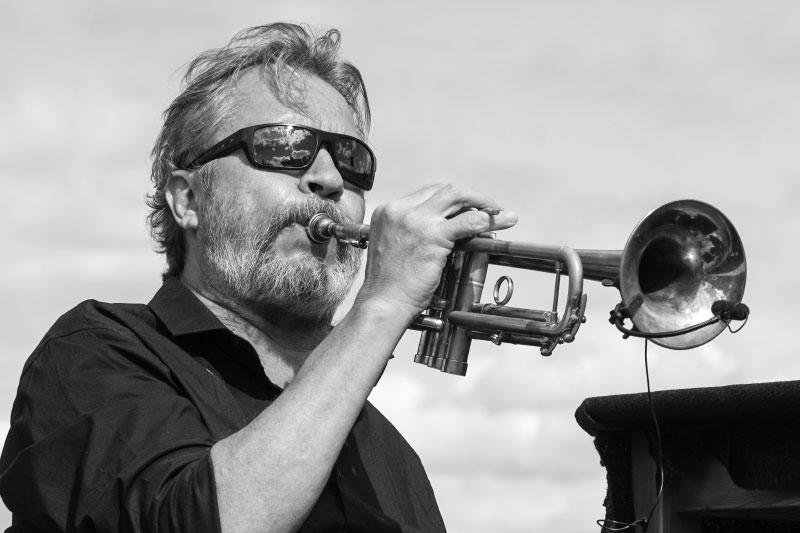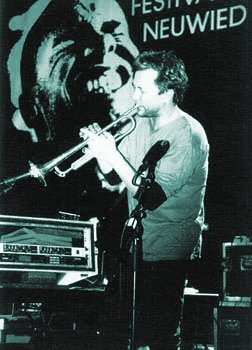1. Early Life and Musical Beginnings
Nils Petter Molvær's musical journey began in his native Norway, where he developed a strong foundation in jazz before embarking on his influential career.
1.1. Childhood and Education
Molvær was born and raised on the island of Sula, Møre og Romsdal in Norway. At the age of 19, he moved to Trondheim to pursue formal musical education. From 1980 to 1982, he attended the Trondheim Musikkonservatorium, specializing in their jazz program, which provided him with crucial training and exposure to the jazz scene.
1.2. Early Band Activities
During his formative years, Molvær became an active participant in Norway's burgeoning jazz scene. He joined several notable bands, including Jazzpunkensemblet alongside guitarist Jon Eberson. His most significant early collaboration was with the band Masqualero, where he played alongside esteemed musicians such as Arild Andersen, Jon Christensen, and Tore Brunborg. Masqualero, named after a Wayne Shorter composition originally recorded by Miles Davis, recorded several albums for ECM Records. Before his solo debut, Molvær also recorded with other artists associated with the prestigious ECM label.
2. Musical Career and Style
Nils Petter Molvær's solo career has been marked by a distinctive evolution, pioneering a new sound that blends traditional jazz with electronic elements, and showcasing his unique compositional approach.

2.1. Musical Characteristics and Influences
Molvær is recognized for his groundbreaking work in "future jazz," a genre he helped define by seamlessly fusing jazz with electronic music, rock, and even hip-hop beats. His sound contrasts sharply with the delicate "chamber jazz" typically associated with ECM Records, the label that released his early solo work. His unique trumpet sound is often muted and electronically processed, demonstrating a clear influence from Miles Davis's work in the 1970s and 1980s, yet maintaining an original voice that avoids being a mere imitation. His innovative approach led ECM, for the first time, to release singles from his album Khmer, specifically "Song of Sand" (backed with three remixes) and "Ligotage", indicating the commercial appeal and distinctiveness of his music.

2.2. Major Solo Albums and Works
Molvær's solo career took flight with his debut album, Khmer, released in 1997. This album was a critical and commercial success, celebrated for its innovative blend of jazz, rock, electronic soundscapes, and hip-hop rhythms. A remix album, Khmer: The Remixes, followed in 1998, along with the EP Ligotage. In 2000, he released his second major album, Solid Ether, which featured artists like Sidsel Endresen. After Solid Ether, Molvær departed from ECM Records. He continued to release numerous albums, including Recoloured (2001, remixes), NP3 (2002), and the live recording Streamer (2004), which captured a 2002 performance. His 2005 album Er features track names ending with the "er" suffix (e.g., "Hover", "Softer", "Dancer"), a play on words with his own name. Subsequent albums include Remakes (2005, remixes), the compilation An American Compilation (2005), Re-Vision (2008, an album compiled from OST outtakes), Hamada (2009), Baboon Moon (2011), Switch (2014), Buoyancy (2016), and Stitches (2021). Several of his albums were also released with Japanese titles, such as Khmer (『クメール』 クメールKhumeruJapanese), Solid Ether (『ソリッド・エーテル』 ソリッド・エーテルSoriddo ĒteruJapanese), NP3 (『NP3』 NP3NP3Japanese), Er (『er』 ererJapanese), Re-Vision (『リ・ヴィジョン』 リ・ヴィジョンRi VijonJapanese), Baboon Moon (『バブーン・ムーン』 バブーン・ムーンBabun MūnJapanese), and Switch (『スウィッチ』 スウィッチSuwitchiJapanese).
2.3. Film and Theater Music
Beyond his studio albums, Nils Petter Molvær has made significant contributions to film and theater as a composer. His work includes the soundtrack for the 2005 film Edy, directed by Stéphan Guérin-Tillié. The album Re-Vision (2008) is notably composed of outtakes from his original soundtrack projects, underscoring his extensive engagement with visual media.
3. Collaborations and Projects
Throughout his career, Nils Petter Molvær has engaged in a diverse range of collaborations with renowned musicians and participated in various musical projects. He frequently works with guitarist Eivind Aarset, a notable collaborator. Molvær has also been involved with Tabla Beat Science, a project initiated by Zakir Hussain and Bill Laswell, further showcasing his versatility across different musical genres.
His collaboration discography includes:
- 1990: So I Write, with Sidsel Endresen, Django Bates, Jon Christensen
- 1995: Hastening Westward, with Robyn Schulkowsky
- 1997: Small Labyrinths (recorded 1994), in Marilyn Mazur's Future Song
- 2005: Electra, in Arild Andersen Group
- 2008: Corps Electriques, with Hector Zazou/KatieJane Garside, Bill Rieflin, Lone Kent
- 2013: 1/1, with Moritz von Oswald
- 2015: Infolding, in Spin Marvel (featuring Martin France on drums, Tim Harries on bass, Terje Evensen on live electronics, Nils Petter Molvær on trumpet, and Emre Ramazanoglu on production and additional drums)
- 2015: Høst: Autumn Fall (OST), with Mapping Oceans
- 2018: Nordub, with Sly & Robbie
- 2019: Music for Paintings, with Terje Evensen, Leo Abrahams, Anna Stereopoulou, Anthony Cox, Manongo Mujica
- 2023: The Harmony Codex with Steven Wilson
- 2024: Liminal Animals with Ulver
4. Awards and Honors
Nils Petter Molvær has received significant recognition for his musical contributions, accumulating several prestigious awards throughout his career.
- 1996: Kongsberg Jazz Award
- 1997: Spellemannprisen in the Open class
- 1998: Gammleng-prisen in the Jazz class
- 2000: Spellemannprisen in the Open class
- 2003: Buddyprisen
- 2005: Spellemannprisen in the Open class
- 2010: Edvardprisen in the «Open class»
- 2016: Spellemannprisen in the Jazz class
5. Discography
Nils Petter Molvær's extensive discography includes numerous solo albums, collaborative projects, and appearances as a featured artist, reflecting his diverse and prolific career.
5.1. Solo Albums
- 1997: Khmer
- 1998: Khmer: The Remixes (promo only)
- 1998: Ligotage (EP)
- 2000: Solid Ether (feat. Sidsel Endresen and others)
- 2001: Recoloured (remixes)
- 2002: NP3
- 2004: Streamer (recorded live in 2002)
- 2005: Er
- 2005: Edy (soundtrack to the film by Guérin-Tillié)
- 2005: Remakes (remixes)
- 2005: An American Compilation (compilation)
- 2008: Re-Vision (OST outtakes merged into an album)
- 2009: Hamada
- 2011: Baboon Moon
- 2014: Switch
- 2016: Buoyancy
- 2021: Stitches
5.2. Masqualero Albums
- 1983: Masqualero
- 1985: Bande À Part
- 1987: Aero
- 1990: Re-Enter
5.3. Other Collaboration Albums
- 1990: So I Write, with Sidsel Endresen, Django Bates, Jon Christensen
- 1995: Hastening Westward, with Robyn Schulkowsky
- 1997: Small Labyrinths (recorded 1994), in Marilyn Mazur's Future Song
- 2005: Electra, in Arild Andersen Group
- 2008: Corps Electriques, with Hector Zazou/KatieJane Garside, Bill Rieflin, Lone Kent
- 2013: 1/1, with Moritz von Oswald
- 2015: Infolding, in Spin Marvel
- 2015: Høst: Autumn Fall (OST), with Mapping Oceans
- 2018: Nordub, with Sly & Robbie
- 2019: Music for Paintings, with Terje Evensen, Leo Abrahams, Anna Stereopoulou, Anthony Cox, Manongo Mujica
- 2023: The Harmony Codex with Steven Wilson
- 2024: Liminal Animals with Ulver
5.4. As Featured Artist
- 1990: Nonsentration - Jon Balke
- 1992: Night Caller - Rita Marcotulli
- 1993: Exile - Sidsel Endresen
- 1997: Brytningstid - Kenneth Sivertsen
- 1998: Électronique Noire - Eivind Aarset
- 2001: Radioaxiom: A Dub Transmission - Bill Laswell & Jah Wobble
- 2003: Digital Prophecy - Dhafer Youssef
- 2004: Seafarer's Song - Ketil Bjørnstad
- 2006: Mélange Bleu - Lars Danielsson
- 2007: A Pure Land - Sienná
- 2007: Ataraxis - Deeyah
- 2007: 23 Wheels of Dharma - Somma
- 2008: Dome - Johannes Enders
- 2008: Lodge - Fanu & Bill Laswell
- 2012: Manu Katché - Manu Katché
- 2015: Deeper Green - Christof May
- 2017: Hypersomniac - Lef
- 2019: Hyperuranion - Chat Noir
- 2021: Roses of Neurosis - Sivert Høyem
5.5. Other Appearances
- Beginner's Guide to Scandinavia (3CD, Nascente 2011)
6. Legacy and Influence
Nils Petter Molvær's legacy is marked by his pioneering role in expanding the boundaries of jazz music. By integrating electronic soundscapes, rock sensibilities, and hip-hop rhythms into a cohesive and expressive form, he paved the way for the "future jazz" movement and influenced a generation of musicians. His distinctive trumpet sound, often processed and atmospheric, has become instantly recognizable and has inspired artists seeking to blend acoustic instrumentation with modern production techniques. Molvær's work, particularly Khmer, is considered a landmark album that demonstrated the commercial and artistic viability of such fusions, ensuring his lasting impact on both the jazz and electronic music scenes.